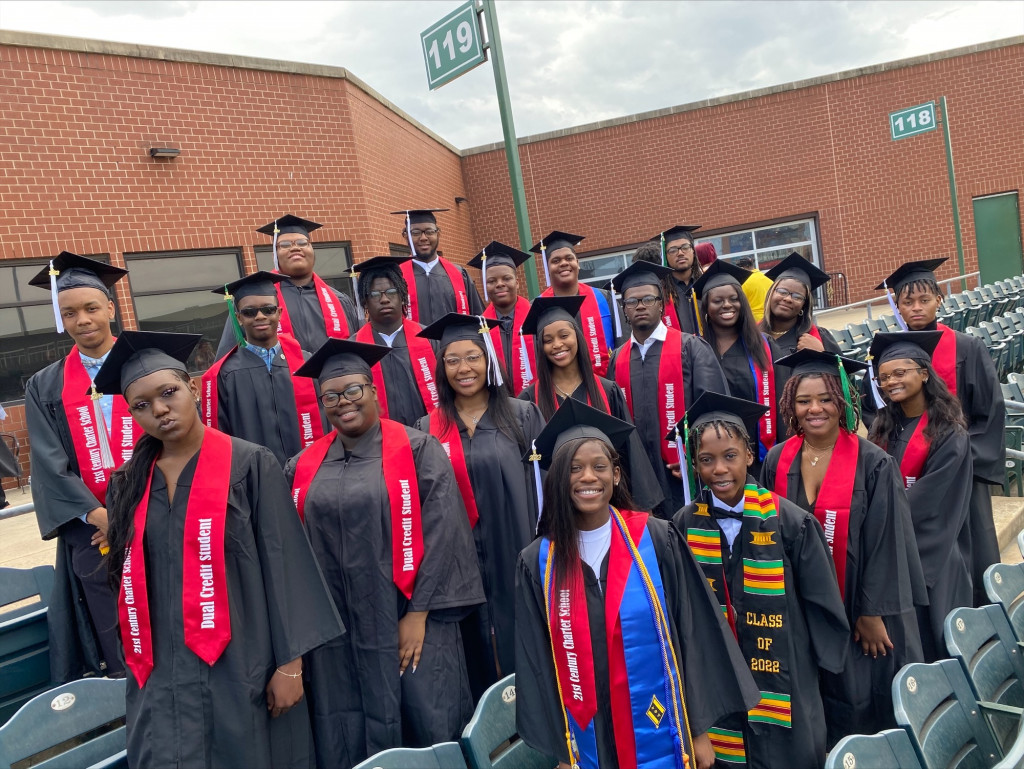
For the past dozen years, the GEO Foundation nonprofit has offered students enrolled at its high schools access to higher education through its college campus immersion program. A state grant for $8.3 million has allowed it to expand the program statewide.
A new study shows that the lines between K-12 and higher education are getting blurrier.
State of play: The Community College Research Center found enrollment declined after the pandemic among all age groups except one: Those younger than 18. A growing share of high school students are participating in dual enrollment programs that allow them to earn college credit. Today, one in five community college students are high school students.
Why it matters: The cost of a college degree continues to rise. So do feelings of boredom among high school students. Getting an early start on a degree can make college less costly and offer high school students more relevant learning opportunities. Some students end up earning associate degrees when they receive their high school diplomas.
Yes, but: Despite the increase in popularity of dual enrollment across the nation, participation remains uneven among states. Idaho, which reported 40% of its high schoolers enrolled in dual enrollment, took the No. 1 spot, followed by Indiana, with 39%. Oregon had the lowest participation, with 8%. Florida reported 12%, which was below the national average of 18% during the fall of 2021.
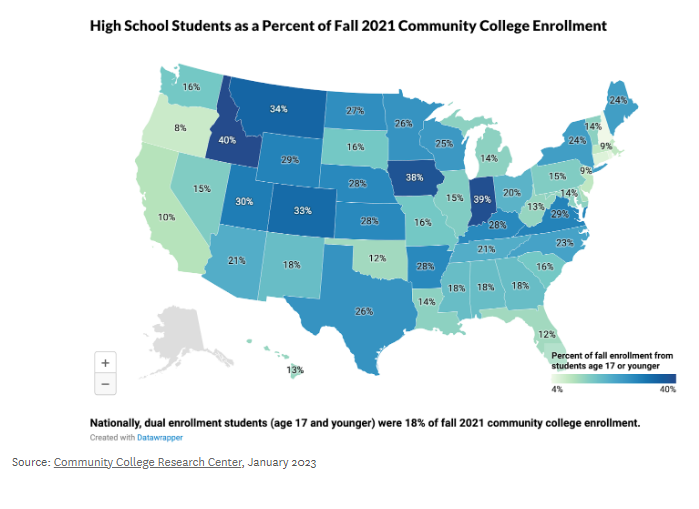
Another way to play: Some states with lower dual enrollment participation rates reported higher participation in Advanced Placement courses, according to the College Board, which administers the AP program. Florida ranked second among the states, with nearly half of the class of 2022 taking an AP exam, another common path to earning college credit during high school.
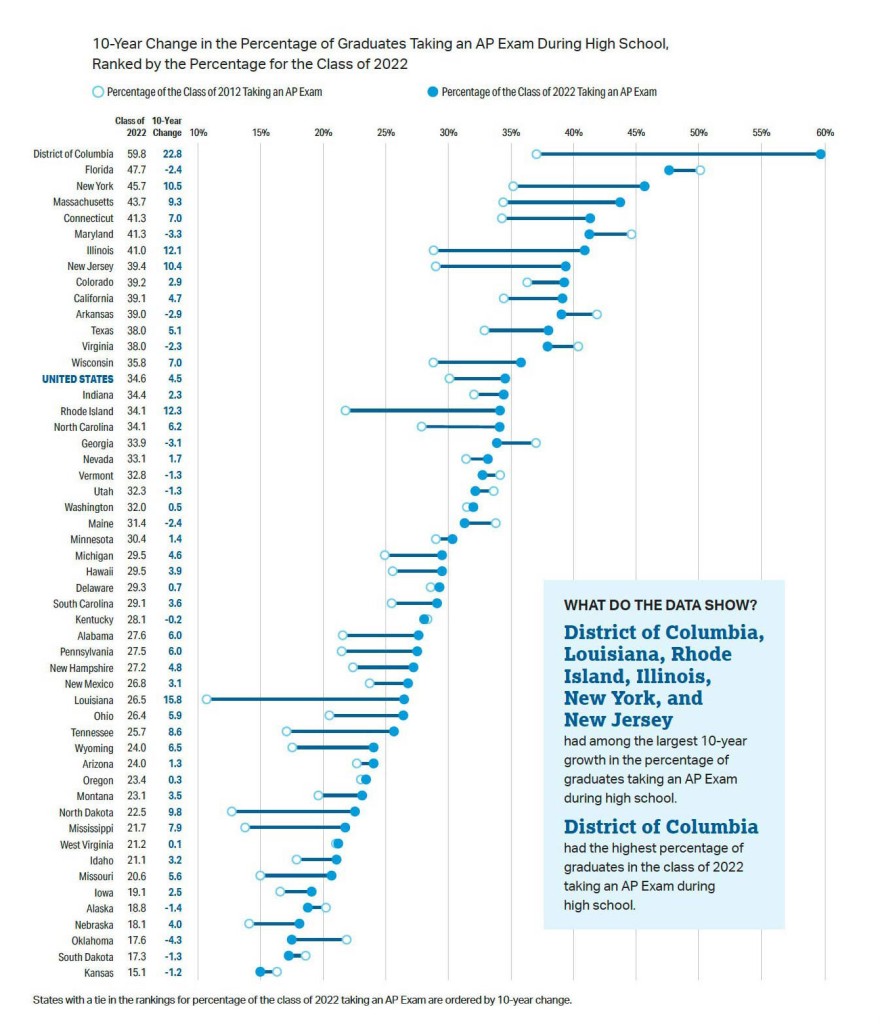
Everyone wins: Regardless of what that looks like — AP, International Baccalaureate, Cambridge, dual enrollment, or career apprenticeship programs — students are finding new ways to gain affordable access to postsecondary education. Some schools, like the Indiana-based charter network GEO Academies or Florida's collegiate high schools, have designed their models around giving students access to higher education institutions or postsecondary career training.

Karen McCabe, a former director of the South Santa Rosa Center at Pensacola State College, has been selected as principal of Pensacola State College Charter Academy. In its inaugural year, the academy is serving 150 students from military families and students deemed at risk of dropping out.
As the rising cost of college continues to push higher education out of reach, programs that allow high schoolers to earn college credits are soaring in popularity. Many dual enrollment programs traditionally have been offered within public and private high schools, while others have allowed students to attend classes on the campus of the participating college.
Now, colleges such as Pensacola State College in Florida’s Panhandle are bringing entire high schools to their campuses for dual enrollment, offering students the chance to earn an associate degree alongside a high school diploma.
Pensacola State College Charter Academy opened Aug. 8 on the college’s Warrington campus to about 150 students from military families and students deemed at risk of dropping out.
"(Military) children may be in one school for two years, another one for two years, another one for two years. Their parents are always looking for quality opportunities for their children, so this gives them another choice," Capt. Tim Kinsella, base commander of Naval Air Station Pensacola, told the Pensacola News Journal.
"It gives them an opportunity that is something more than just a high school because of the opportunities that this presents. It's almost an attraction for military families to come here."
Pensacola State College Charter Academy’s inaugural class is comprised of high school juniors and seniors; sophomores will be accepted in the fall of 2024. About 80% of students were required to meet charter school entry requirements, while 20% of the space was reserved for students specifically at risk of dropping out. Military families are exempt from meeting the entry requirements.
Authorized by the Escambia County School District, the academy got a funding boost with a $100,000 donation from the Gulf Power Foundation toward a technology innovations center, housed within the school, which will offer students access to virtual simulations of various types of careers.
"It'll be more than just access to the internet,” academy president Ed Meadows said.
Karen McCabe, a former school principal in New York and director of the South Santa Rosa Center at Pensacola State, was tapped to be principal at the new charter academy. During her tenure at the Santa Rosa Center, she worked with two of the largest local high schools to offer dual enrollment with the college and helped to increase participation.
The academy will focus heavily on careers, particularly those grounded in science, technology, engineering and math. Students will be required to complete a capstone project related to their desired career path prior to graduation.
“They will do some heavy research with an individual in that field and possibly shadow them,” McCabe told Pensacola’s WEAR-TV.
Pensacola State College Charter Academy is part of the dual enrollment boom that has taken the nation by storm in recent years. Between the 2002-03 and 2010-11 academic years, the number of high school students taking college courses for credit increased by 68% to nearly 1.4 million according to federal data. By 2015, nearly 70% of high schools offered dual enrollment, according to the Government Accountability Office.
Hailed as game-changers for lower-income students, the programs have allowed many to get a free head start on a college degree they otherwise might not be able to afford. The programs also help local colleges, which have seen enrollments plummet since the end of the Great Recession in 2010.
In Florida, an 8-year-old legal glitch that left no funding for nonpublic schools to provide dual enrollment resulted in a 60% drop in enrollment among independent and faith-based schools. The Florida Legislature in 2021 corrected the problem by passing SB 52, which set aside $15.5 million in state money to cover the costs for homeschooled and private school students who participate in dual enrollment programs by taking courses from a partnering college or university.
The legislation was a top priority of private school leaders, who had been forced to stop offering dual enrollment at their high schools because of the costs. Many, including Steve Hicks, vice president of operations for Center Academy, which operates 10 campuses in Florida for students with learning disabilities, praised lawmakers for passing the legislation.
“Studies clearly show that students who have an opportunity to take dual enrollment courses are more likely to attend a college after high school,” Hicks said. “The fact that so many families, like the ones we serve, were not able to take advantage of this opportunity due to financial or other reasons was extremely frustrating.”

For the past dozen years, the GEO Foundation nonprofit has offered students enrolled at its high schools access to higher education through its college campus immersion program. A state grant for $8.3 million has allowed it to expand the program statewide.
Kevin Teasley loves success stories.
That’s because he has plenty of them to tell.
There’s the student who was on the verge of dropping out of school, only to graduate from high school with a college degree. Then there’s the academically gifted student who started taking college courses at age 13 and earned his bachelor’s degree before he got his high school diploma.
“We have a very different approach to empowering families with choices,” said Teasley, founder of the Indianapolis-based Greater Education Opportunities Foundation, also known as the GEO Foundation, which operates a mix of charter and private schools in Indiana and Louisiana. “Even within our schools we have a very different approach. We don’t believe the money that comes from the state belongs to us. We believe the money belongs to the students.”
Teasley started the nonprofit organization in 1998 to support all quality means of educating children, including public, private, charter and religious schools as well as homeschooling. The foundation also works to develop a community understanding of school choice to align with its belief that providing families with a menu of educational options will strengthen all schools.
Teasley has even more stories these days, thanks to an $8.3 million grant that the Greater Education Opportunities Foundation received from the Indiana Department of Education in 2021. GEO used the grant to extend its college immersion program to six Indiana schools and a public school district.
“When you apply for these grants, you ask for the moon, not expecting to get the moon,” he said. “We got the moon.”
The program allows high school students to take college courses. However, a partnership with the colleges lets the students travel to the local campuses, unlike most dual enrollment programs where students take the classes at their high schools from their own teachers who have been specially trained.
“There’s nothing wrong with that,” he said, “but we don’t think that is as powerful an experience as putting students on a college campus, so they get that whole climate, that culture and experience from a real college professor, from students sitting next to them who aren’t their high school buddies, but other college students, and they could be adults. So, our students get the whole experience while they are at our schools.”
GEO had been offering the program to students enrolled at its own schools for about a dozen years. Teasley says it has helped turn many would-be dropouts into first-generation college graduates.
He said many students at GEO schools, which cater to families who are low-income and minorities, didn’t consider higher education because they have no college role models in their families. At GEO’s school in Gary, Indiana, a community with 50% high school dropout rates, GEO first tried the traditional college prep approach when it opened the school in 2005. They talked up the advantages of college degrees, including higher-paying careers. They arranged for campus tours.
All of that failed.
“It was going right over the heads of kids,” Teasley said. What the students told him was that they valued school mainly for its social scene.
“They said, ‘I’m not really going to high school to go to college. I’m in high school because this is where my friends are. This is where I get to play football. This is where I get to play basketball.’”
Teasley decided he had to change that mindset.
“These kids are smart, but they’re not thinking beyond high school, and what incentive do they have to do well on those state tests or on SAT and ACT tests because they’re not going to college, so why would they do their best on them?”
One 16-year-old student had planned on dropping out. Most of his adult relatives had dropped out, and he didn’t consider himself college material. Teasley challenged him to take the entrance exam at Ivy Tech Community College. If he passed, the school would pay for him to take classes on campus.
When the test results came back, the teen’s eyes lit up as he saw his passing score. Teasley said he was now a college student and would be taking classes at Ivy Tech for free.
“I’ll start paying for you to go to college,” Teasley recalled. “We’re going to do that while you are at my high school.”
The student, who originally had planned to drop out of high school, not only earned his diploma but also an associate degree, an achievement that still makes Teasley swell with pride.
So, when it came time to apply for the competitive acceleration grant, GEO’s application stood apart from the pack.
The department planned to award the grant as part of its initiative to accelerate learning, which for most schools meant remediation for pandemic learning loss. However, Teasley is quick to point out that not everyone fell behind in 2020.
“Many of our students in Gary, Indiana, Baton Rouge and Indianapolis chose to use that time to accelerate, and by that, I mean that that we empowered them to enroll in college courses,” he said. “We had students earn their associate degrees during COVID. They didn’t lose ground; they accelerated.”
Teasley said those students’ experiences inspired his foundation to apply for the grant to help more students across the Hoosier State attend college while in high school.
The GEO Foundation is partnering with six schools and the Vigo County School Corp. in Terre Haute, Indiana. The grant is being used to pay college tuition, tutors and other staff to support the participating students, as well as transportation, which Teasley admits is one of the most challenging areas to administer.
“We’re like air traffic controllers,” he joked.
The programs have paid off, with Teasley estimating that more than 1,000 students have benefited from the grant. Those results align well with GEO’s mission of helping students improve their lives by removing barriers to better education.
For families of modest means, the biggest barrier to college is cost.
“We’re paying full freight for students to get college courses,” Teasley said. “If it’s $1,000 per class, that’s what we pay. We do that because we think it’s a valuable experience for kids. It gives students a reason to stay in high school because they begin to believe they are college capable.”
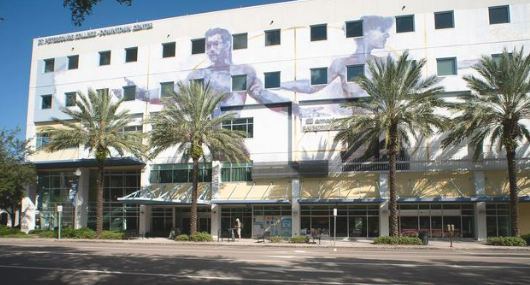
St. Petersburg College recently announced the opening of its third collegiate high school, a charter school situated on its downtown St. Petersburg campus, that will allow students to simultaneously earn high school diplomas and associate of arts degrees at no cost to students and families.
Like their counterparts nationally, many of Florida’s locally governed public colleges experienced enrollment declines before the pandemic that only grew steeper after its onset.
Also like their counterparts, these post-secondary schools, which, like state universities, are coordinated under the jurisdiction of the State Board of Education, have been exploring and adopting strategies to fill their seats.
Valencia College on Florida’s east coast, for example, began offering scholarships to students who failed remote classes they attended during the pandemic, allowing then to repeat the classes on campus as in-person instruction resumed.
Others started “summer bridge” programs to help new students feel more prepared when the fall term starts.
Programs that have gained the most attention are those that reach prospective students before they receive high school diplomas. Those include dual enrollment options that allow students to attend classes on college campuses or take courses from high school faculty members specially trained to teach them, as well as early college high school programs that allow students to earn college credits while completing their high school diplomas.
To facilitate the former, Florida lawmakers in 2021, after years of participation decline among private schools due to prohibitive costs, approved funding to cover tuition and fees for private school students who take dual enrollment classes. (Funding already had been in place for public school students through their school districts, and state law barred colleges from charging home school students who participated.)
The most recent example of the latter is St. Petersburg College in Florida’s Tampa Bay area, which recently announced the opening of its third collegiate high school. The new school will use $2 million in new state funding, and unlike the two existing collegiate high schools, will be open to freshmen.
The first collegiate high school under St. Petersburg College auspices opened as a public charter school of choice in 2004 on the St. Petersburg/Gibbs campus. A cavalcade of honors followed. Newsweek named it one of America’s Top High Schools in 2016, ranking it No. 2 in Florida and No. 55 in the nation. U.S. News & World Report named St. Petersburg Collegiate High School to its list of 2019 Best High Schools.
The new downtown St. Petersburg campus will allow students in grades 9-12 to simultaneously earn a high school diploma, two industry certifications and an associate in science degree. Like the other two collegiate high school campuses, there will be no cost to students for books, fees or tuition.
Starla Metz, St. Petersburg College’s vice president of collegiate high schools, said the college’s newest pre-collegiate program will infuse reading, writing, critical thinking, research and college readiness skills into its curriculum. Juniors and seniors will take part in the collegiate program, where they dual enroll in college classes.
Overall, the school will focus on preparing students for careers in science, technology, engineering and math, commonly referred to as STEM.
Metz recently told St. Pete Catalyst that as technology evolves, STEM education is “absolutely critical” to prepare students for high-paying jobs. Like its counterparts, the new campus in downtown St. Petersburg will offer associate degrees in computer information technology, data systems and business intelligence.
With some additional courses over the summer, graduating seniors can earn their associate in arts degree to continue their education at St. Petersburg College or another Florida college or university.
“We’re really excited because we think STEM is the future, and that’s where our students are going to have the opportunity to have economic mobility for themselves and their families," Metz said.
Research from the non-profit, non-partisan American Institutes for Research on the impact of early college programs showed a substantial positive impact not only on college enrollment but degree completion each year between the fourth year of high school and six years after expected high school graduation.
The study also found that early college students complete college degrees earlier and faster than those who did not participate.
While some of the nation’s most prestigious universities have celebrated banner years for applications, the pandemic has been hard for most post-secondary institutions. More than 1 million fewer students are enrolled in college now than before the pandemic began. According to data released in January by the National Student Clearinghouse, U.S. colleges and universities saw a drop of nearly 500,000 undergraduate students in the fall of 2021, continuing a historic decline that began the previous fall.
Compared with the fall of 2019, the last fall semester before the coronavirus pandemic, undergraduate enrollment fell a total of 6.6%, representing the largest two-year decrease in more than 50 years.
The nation's community colleges were hit even harder, with a 13% enrollment drop over the course of the pandemic. But the fall 2021 numbers showed that bachelor's degree-seeking students at four-year colleges made up about half of the decline among undergraduates.
Researchers found that many students who took a gap year during the pandemic weren’t returning. Speculation was that many were choosing to work as the economy rebounded and jobs became plentiful.
"The phenomenon of students sitting out of college seems to be more widespread. It's not just the community colleges anymore," said Doug Shapiro, who leads research at the National Student Clearinghouse and who spoke to NPR about the report.
"That could be the beginning of a whole generation of students rethinking the value of college itself. I think if that were the case, this is much more serious than just a temporary pandemic-related disruption."
For information about St. Petersburg College’s new STEM collegiate high school located in downtown St. Petersburg, as well as the college’s other two collegiate high school locations, click here.
 Students who were not able to receive funding this year from the Family Empowerment Scholarship for Students with Unique Abilities could get some relief if the Florida Legislature approves Senate Bill 2524, which won unanimous approval in that chamber Thursday
Students who were not able to receive funding this year from the Family Empowerment Scholarship for Students with Unique Abilities could get some relief if the Florida Legislature approves Senate Bill 2524, which won unanimous approval in that chamber Thursday
The bill, which would raise the limit on the number of students who can receive the state scholarships from 20,000 to 26,500 during the 2022-23 school year, also addresses the needs of struggling young readers and includes new provisions for private school students in dual enrollment programs.
The boost in the number of scholarship recipients does not include students in certain categories, such as those who are adopted or in foster care, are dependents in military families, and those who received specialized services in a voluntary pre-kindergarten program, have an Individualized Education Plan or who previously received funding from the McKay Scholarship Program, which will merge with the Family Empowerment Scholarship for Unique Abilities program beginning with the next school year.
The move would fund students who applied but did not receive money this year due to lack of funding and is expected to cost about $16 million, according to a state analysis of the bill.
State figures show that FES program scholarships awarded through December 2021 for the 2021-2022 school year were 24,694 for Unique Abilities option scholarship recipients. As of January 2022, more than 6,400 students eligible for a Unique Abilities scholarship were placed on a waitlist.
Starting in the 2023-24 school year, the maximum number of students participating under the Unique Abilities option would be allowed to annually increase by 1% of the state’s total exceptional student education enrollment, not including gifted students, approximately 4,500 students per year. An eligible student who meets specified requirements is excluded from the maximum number of students.
The bill also includes language that further hones legislation passed last year that established a $15.5 million state fund to cover the costs of private school students who take dual enrollment courses that allow them simultaneous earn college credit while in high school.
Under the bill, private school and homeschool students would receive free instructional materials for dual enrollment courses. Another provision, opposed by a statewide private school advocacy group because it fears it will have the effect of limiting private school students to dual enrollment classes outside of traditional school hours, remained in the bill upon approval Thursday.
Although the bill received a vote on the Senate floor, its fate remains uncertain. The bill will be sent to the House of Representatives and a conference committee, which will draft a final version based on what is approved in both chambers before a final vote is taken.
 Last year, private school families celebrated legislation that created a $15.5 million state fund to cover the costs of private school students who participated in dual enrolment programs that allowed them to earn college credit in high school.
Last year, private school families celebrated legislation that created a $15.5 million state fund to cover the costs of private school students who participated in dual enrolment programs that allowed them to earn college credit in high school.
Supporters of Senate Bill 52 saw it as a restoration of fairness to a program that private school students were essentially shut out of since 2013, when a legislative change shifted the costs from colleges and universities to school districts. But no funding was put in place for private schools to participate without requiring families to bear the cost.
A law passed in 2018 did not spell out who would be responsible for private school costs and only continued to muddy the waters. After several attempts to approve a fix, lawmakers finally were able to get legislation over the finish line in 2021. For lower-income students who rely on state K-12 school choice scholarships, the opportunity to graduate from high school with up to two years of college under their belts was seen as a game changer.
Just a year later, that opportunity could be threatened by a provision tucked into Senate Bill 2524, an omnibus education bill with a clause that would limit private school reimbursements to courses taken outside regular school hours. Homeschool students, who are also covered by the fund, would not be affected.
Private school advocates have expressed concern because some dual enrollment classes are offered by high school teachers are also certified to teach college classes. The law passed last year did not exclude those classes from reimbursement.
“Unless schools can absorb these costs invoiced by colleges and universities, students will be limited to taking courses after the normal school day,” said James Herzog, director of legislative services for the Florida Association of Academic Nonpublic Schools, an organization representing 1,300 schools with more than 300,000 students.
“Students will be forced to make hard choices such as working part time, playing sports, joining other extra-curricular activities or taking dual enrollment courses.”
The association says such a change could negatively impact 700 schools serving 2,500 students. About 40% of students taking dual enrollment receive state scholarships, many of which are administered by Step Up For Students, the host of this blog.
The change also would place even more barriers to students with special needs or from lower-income families, whose parents would be forced to find transportation to colleges or universities, Herzog explained.
The association has encouraged its members to contact lawmakers about the bill, which is scheduled to come up on Senate floor today for a second reading before heading to a final vote. No such provision is included in any of the House education bills, so the chances of the provision surviving remain uncertain.
(You can watch the Senate session live starting at 10 a.m. by clicking here. A schedule of live streams is on the right side of the page.)
Herzog says the proposed restriction stems from a misunderstanding about how private schools are funded for dual enrollment. Public schools are reimbursed for classes taken at the college or university campus, but current law is silent about where or when nonpublic students take courses.
He said nothing precludes the colleges or universities from negotiating cost-sharing agreements with private schools if under current law, the demand for dual enrollment exceeds the funding that the legislature sets aside for private schools.
Some may interpret the current law as allowing private schools to double dip, Herzog said, but that doesn’t take into consideration higher levels of taxpayer funding that are available to public school districts.
“Public school students generate several thousand dollars each in additional local, state or federal funding beyond the basic per-child funding of FEFP, the Florida Education Finance Program,” he said.
Private school advocates hope they will be able maintain the momentum that last year’s law created to expand participation rates, which had declined by 60% between 2010 and 2020 while rates for district schools and homeschools more than doubled.
Private school leaders say they don’t to reverse gains in dual enrollment participation rates made possible by last year’s legislation.
“I am disappointed to see legislation put into place that seems to be specifically targeting low-income minority children, preventing them from getting the dual enrollment experience that will make a huge impact in their lives,” said Adam Gaffey, head of school at Robert F. Munroe Day School in Quincy, Florida, where 60 students representing about a third of the high school population participate in dual enrollment.
Of all Robert F. Munroe high schoolers, about 70% receive income-based state scholarships, and half are minority students. Many would be first-generation college graduates, Gaffey said.
“They do not have the financial means nor the time to attend classes outside the school day, nor are they able to afford the additional costs associated with dual enrollment without the current law that helps support them,” he said.
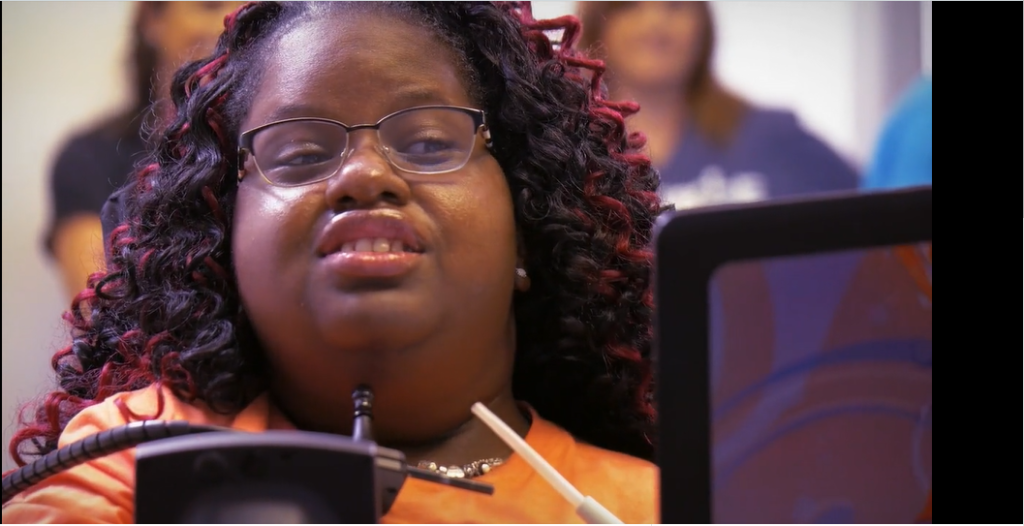 Editor’s note: To hear Dyani Peterson tell her own story, click here.
Editor’s note: To hear Dyani Peterson tell her own story, click here.
As a high school student at No Limits Academy in Melbourne, Florida, Dyani Peterson took dual enrollment classes from Eastern Florida State College.
She crushed it.
She graduated in 2020 with her high school diploma from No Limits, an associate degree from Eastern Florida, and was among those chosen to represent the college on the 2020 All-Florida Academic Team, which consisted of 166 students from the 28-member Florida College System.
The 21-year-old’s story is even more amazing given the fact she has arthrogryposis multiplex congenita, a condition that results in decreased flexibility of the joints. The disease has progressed to the point where Peterson can move only her head.
“The dual enrollment program has ended up making me successful for my college career today,” said Peterson, who attended No Limits on a Gardiner Scholarship. “I know that with my complex physical disabilities and all the adaptions I needed, my tuition did not touch the cost of educating me, but No Limits Academy did it anyway, because they saw my future.”
Now a biomedical engineering major at Florida Institute of Technology, Peterson is urging lawmakers to support SB 52 and HB 281, which would set aside $12.5 million to cover the cost of dual enrollment for private school students as well as students who are educated at home. The bills, currently being debated in legislative committees, also include $16 million to cover the cost of summer courses for all dual enrollment students.
The legislation has been proposed for the past several years to correct a glitch in state law that happened in 2013. Funding issues occurred at that time when a change in the law shifted the cost of dual enrollment programs from colleges to school districts. Because school districts are state funded, the state picked up the cost. But private schools, faced with having to pick up the costs themselves, had no alternative but to limit their dual enrollment offerings.
Despite bipartisan support, the bills died in committee. Supporters hope 2021 will be the year the issue gets corrected.
Sen. Ray Rodrigues, R-Fort Myers, the bill’s sponsor, said this latest attempt to correct the problem benefits the state overall because students who participate in dual enrollment go to college at a much higher rate than their classmates and are more likely to earn college degrees than their peers.
And because the bills would provide relief to private schools, students like Peterson would benefit. While she was aware she could have gone to a district school and had her dual enrollment costs covered by the state, her condition required that she attend a private school like No Limits Academy, which specializes in educating students with complex physical issues.
No Limits Academy founder and director Laura Joslin said she’s proud of all that Peterson and her other dual enrollment students have accomplished. She encourages students whose abilities make college a suitable fit for them to pursue their dreams regardless of what it costs her school.
“I work hard to raise $100,000 in donations every year so that I can help my students overcome physical challenges to get the best education they possibly can,” Joslin said. “That includes dual enrollment.”
If approved, the new law would allow her to shift those dollars toward more equipment and staff so that more students at No Limits can receive a high-quality education.
And that might just lead to even more students with unique abilities earning college diplomas.
 A bill that would allow more students to get a head start on college won approval from a Senate panel Tuesday.
A bill that would allow more students to get a head start on college won approval from a Senate panel Tuesday.
Members of the Senate Appropriations Subcommittee on Education voted 6-3 along party lines to approve SB 52, with Republicans supporting the bill.
SB 52 would set aside $12.5 million in state money to cover the costs for homeschooled and private school students who participate in dual enrollment programs by taking courses from a partnering college or university. The bill also would allocate $16 million to cover the costs of dual enrollment courses taken during the summer for all Florida students, including those who attend public schools.
“What is new is that we are also providing the funding for students in private schools,” said the bill’s sponsor, Sen. Ray Rodrigues, R-Fort Myers.
Rodrigues said the bill also creates a funding mechanism to prevent the colleges from having to absorb all dual enrollment costs for homeschooled students. The law currently provides for public school funding as part of the state’s education funding formula, but only during the regular academic year. Senate Bill 52 would expand that funding by covering costs for all students who enroll in summer dual enrollment classes.
Issues surrounding dual enrollment funding occurred in 2013 when a change in the law shifted the cost of dual enrollment programs from colleges to school districts. Because school districts are state funded, the state picked up the cost. But private schools, which were not allowed pass the cost on to their students, had no alternative but to limit their dual enrollment offerings. (The law already prohibited colleges passing along the costs to homeschooled students.)
As a result, the number of students in private schools taking dual enrollment courses has decreased by 60%, even as public school student enrollment doubled during the same period.
The situation dramatically affected school choice scholarship students. During the same enrollment period, the number of lower-income students attending private schools on Florida Tax Credit Scholarships more than quadrupled, putting more lower-income students at an even greater disadvantage.
Lawmakers have tried for the past few years to clarify the issue, but proposed legislation never made it to the governor’s desk despite bipartisan support.
Rodrigues said this latest attempt to correct the problem benefits the state overall because students who participate in dual enrollment go to college at a much higher than their classmates and are more likely to earn college degrees than their peers.
Adam Gaffey, head of school at Robert F. Munroe Day School in the rural North Florida community of Quincy, urged senators to support the bill, saying it would make college more accessible to the lower-income and minority students who attend his private school. He said a teacher contacted him recently to say that 25% of her dual enrollment students couldn’t afford textbooks for those classes.
“Dual enrollment is a gateway to college for so many students,” he said. “Without Senate Bill 52, we will continue to see lower participation in dual enrollment. It’s an investment in Florida that will have a huge return.”
Democrats on the panel criticized the bill, saying it was irresponsible to spend $28.5 million in what might be a challenging budget year. They also called it an attempt to divert money from district schools.
“I’m just worried about our public schools,” said Sen. Janet Cruz, D-Tampa.
Sen. Manny Diaz Jr., R-Hialeah, reminded critics that the state’s formula to pay for education funds students, not institutions, and that bill is an attempt to level the playing field for those who are economically disadvantaged.
Rodriguez pointed out that the bill also benefits public school students by including $16 million to cover the costs of summer courses.
“The bulk of this (bill) benefits the children that (opponents) say they want to protect,” he said.
The bill now moves to the Senate Appropriations Committee. A companion bill, HB 281, sponsored by Rep. Wyman Duggan, R-Jacksonville, is in the House Secondary Education & Career Development Subcommittee.
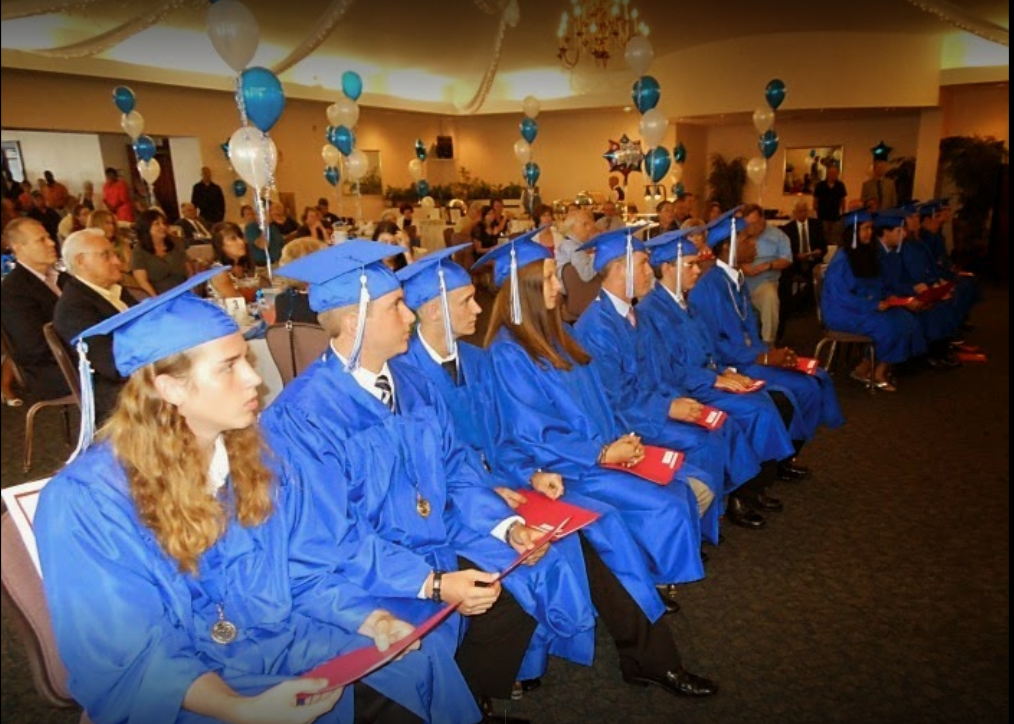
A recently filed bill that would shift the cost of dual enrollment from private schools to the state would benefit schools like Center Academy in Pinellas Park, one in a network of 10 schools across Florida that serve students with learning differences.
The staff at Center Academy used to encourage eligible high school students to enroll in classes through Florida’s dual enrollment program. Not only did it pave the way for those students to get a head start on college; it boosted their confidence and allowed any with reservations if college was the best fit after graduation.
But a loophole in state law that made dual enrollment prohibitively expensive for private schools forced Center Academy and others to limit participation – or not offer the program at all.
“Our students would have a chance to be successful, but we don’t want to offer dual enrollment because the cost makes it difficult for us to operate our school, especially if every student took advantage of the program,” said Steve Hicks, vice president of operations for the Pinellas Park-based network of 10 schools across Florida that serve students in fourth grade through high school with learning differences.
Recent figures from the Florida Department of Education show the inequity that the loophole created has worsened over time, with the number of private school students participating in dual enrollment declining 60% over the past 10 years. District schools, meanwhile, more than doubled the number of dual enrollment students during the same period. Home schoolers also saw their dual enrollment numbers more than double.
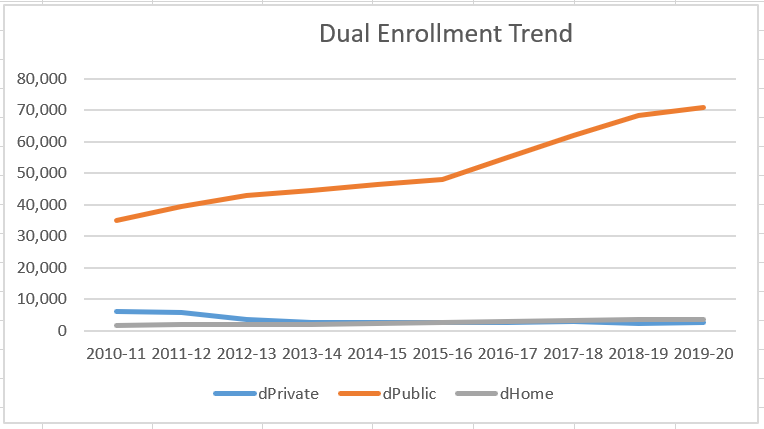 At the same time, the number of lower-income students attending private schools on Florida Tax Credit Scholarships more than quadrupled, putting more lower-income students at an even greater disadvantage.
At the same time, the number of lower-income students attending private schools on Florida Tax Credit Scholarships more than quadrupled, putting more lower-income students at an even greater disadvantage.
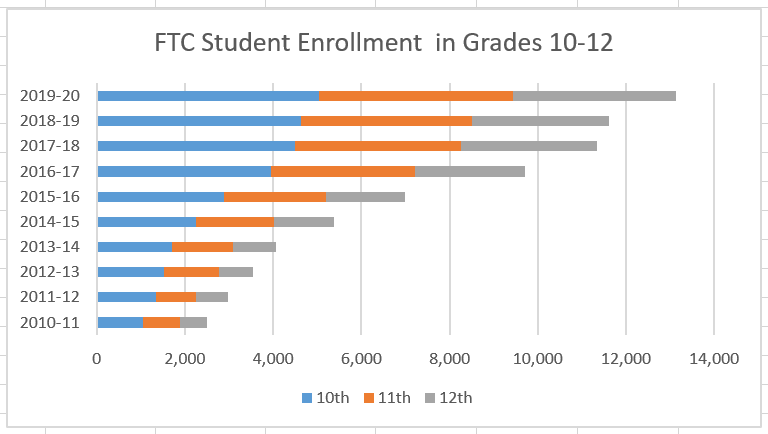 “For years, private school students have had this stumbling block,” said Michael Barrett, who oversees education policy issues for the Florida Conference of Catholic Bishops. “Everyone should have equal access to education. We have 30,000 students on state scholarships and over 22,000 on (income-based) scholarships who could benefit from accelerated college educations while in high school.”
“For years, private school students have had this stumbling block,” said Michael Barrett, who oversees education policy issues for the Florida Conference of Catholic Bishops. “Everyone should have equal access to education. We have 30,000 students on state scholarships and over 22,000 on (income-based) scholarships who could benefit from accelerated college educations while in high school.”
The high cost has forced many Catholic high schools to limit dual enrollment participation to college courses that their own faculty members are certified to teach, Barrett said.
Dual enrollment access first became an issue in 2013 when a change in the law shifted the cost of dual enrollment programs from colleges to school districts. Because school districts are state funded, the state picked up the cost. But private schools, which couldn’t pass the cost on to their students, had no alternative but to limit their dual enrollment offerings.
New provisions for dual enrollment that were expected to address the issue were included in a wide-ranging bill, HB 7055, which then-Gov. Rick Scott signed into law in 2018. One of those provisions removed the requirement that articulation agreements – the documents that allow students to take certain classes at nearby colleges — must specify whether the private schools are responsible for tuition. But educators were not clear on whether colleges or the schools would pay dual enrollment costs.
Private school officials waited for clarification from the state Department of Education, but a memo on the bill did not address the provisions. Lawmakers have tried for the past few years to clarify the issue, but proposed legislation never made it to the governor’s desk despite bipartisan support.
Last year, state Sen. Kelli Stargel, R-Lakeland, sponsored SB 1246, which would have established a state scholarship fund to cover the costs incurred by private schools and homeschool students. (The law already bars colleges from charging homeschool students who take dual enrollment courses.) An analysis estimated the cost at $28.5 million.
The bill won approval from the Senate Education Committee but died in the Senate Appropriations Committee. A companion bill filed by state Rep. Ardian Zika, R-Land O’Lakes, also died in committee.
Supporters haven’t given up hope. This year, lawmakers are making another run at changing the law to shift the cost from private schools to the state. SB52, filed last month by state Sen. Ray Rodrigues, R-Fort Myers, is nearly identical to previous versions.
School leaders hope this attempt will prove successful.
“We have always believed that our students who attempt dual enrollment classes will be more likely to attend college and pursue a degree,” Hicks said. “It is great for their self-esteem to take a college course and find success.”
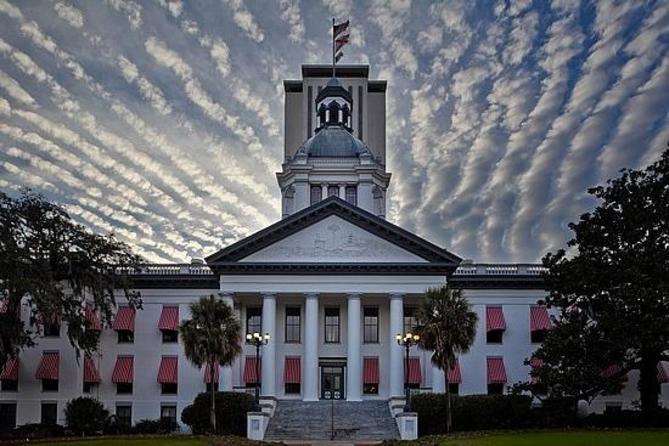
Legislation that would allow all Florida students to take advantage of dual enrollment programs offered by colleges and universities for free won approval today from House and Senate committees.
HB 187, co-sponsored by Rep. Ardian Zika, R-Land O’Lakes, Rep. Susan Valdes, D-Tampa, and Rep. Wyman Duggan, R-Jacksonville, provides $550,000 from the state’s general revenue fund each year to help cover the cost of instructional materials for students at private and charter schools. Last year, the Legislature set aside the same recurring amount to cover those costs for students who are home schooled.
“It’s a first step in the right direction to lower the costs of college,” Zika said during a meeting of the House Education committee, which unanimously approved the bill.
Valdes praised the bipartisanship involved in the development of the bill and said it would help all students succeed regardless of their families’ ZIP codes or income levels.
“To be able to walk out of high school with a degree they would otherwise not have is an amazing opportunity for students,” Valdes said. “This is just a great bill.”
A companion bill in the Senate, SB 1246, sailed through the Senate Education Appropriations Subcommittee with no debate.
“This is an issue I’ve been working on for several years,” said Sen. Kelli Stargel, R-Lakeland. “I believe dual enrollment is a great opportunity for our students.”
Sen. Dennis Baxley, R-Lady Lake, praised the bill for its potential to provide equal opportunity to all Florida families.
“We have taken steps in the past that made sure we were offering dual enrollment to everyone, but we also knew there were some gaps in that,” he said. “We want to make sure everyone has access.
Both bills prohibit colleges and universities from passing along costs to a private school associated with tuition and fees, including laboratory and registration fees as well instructional materials.
The legislation, which would take effect during the 2020-21 school year, also would expand the dual enrollment programs from one to two years to enable more students to earn an associate degree. Currently, the program is open only to high school seniors.
Representatives from several organizations, including the Florida Association of Christian Colleges and Schools, the Florida Council of Independent Schools, the Florida Conference of Catholic Bishops and the Foundation for Florida’s Future, supported the bills.